Scientific name Arthrospira | Family Phormidiaceae Higher classification Phormidiaceae Rank Genus | |
 | ||
Similar Blue‑green bacteria, Bacteria, Chlorella vulgaris, Spirulina, Oscillatoriales | ||
Arthrospira is a genus of free-floating filamentous cyanobacteria characterized by cylindrical, multicellular trichomes in an open left-hand helix. A dietary supplement is made from A. platensis and A. maxima, known as spirulina. The A. maxima and A. platensis species were once classified in the genus Spirulina. Although the introduction of two separate genera [Arthrospira and Spirulina] is now generally accepted, there has been much dispute in the past and the resulting taxonomical confusion is tremendous.
Contents
- Taxonomy
- Morphology
- Biochemical composition
- Occurrence
- Present and future uses
- Cropping systems
- Open pond
- Closed system
- Economy of arthrospira and its market potentials and feasibility
- References
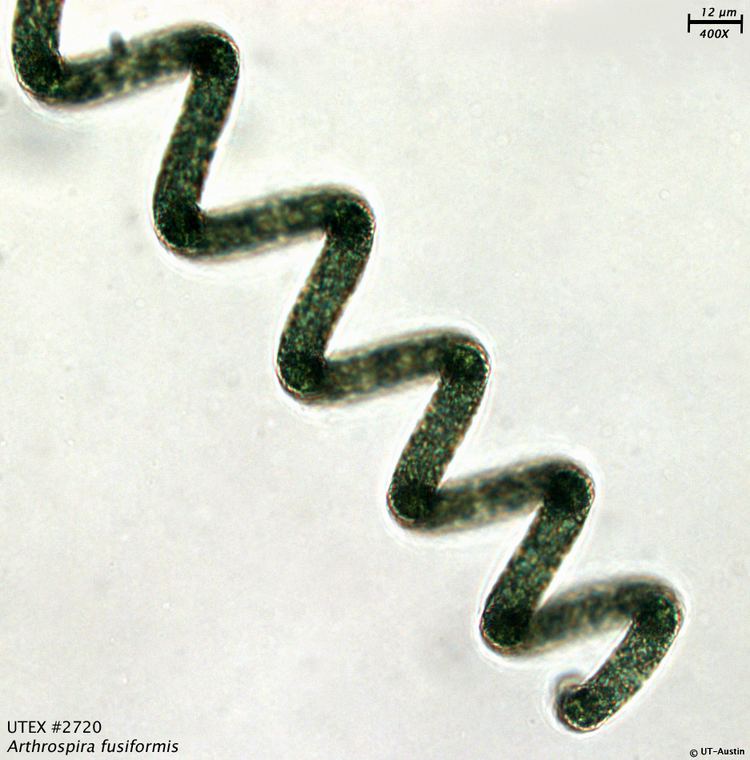
Taxonomy
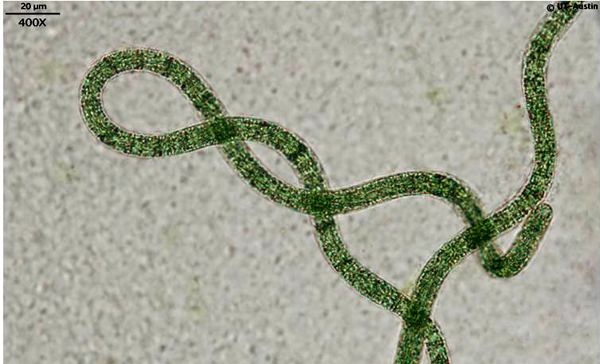
The common name, spirulina, refers to the dried biomass of A. platensis, which belongs to the oxygenic photosynthetic bacteria that cover the groups Cyanobacteria and Prochlorales. These photosynthetic organisms, Cyanobacteria, were first considered as algae until 1962 and for the first time, these blue-green algae were added to prokaryote kingdom and proposed to call these microorganisms as Cyanobacteria where algae are considered to be a very large and diverse group of eukaryotic organisms. This designation was accepted and published in 1974 by Bergey's Manual of Determinative Bacteriology. Scientifically, quite a distinction exists between Spirulina and Arthrospira genera. Stizenberger, in 1852, gave the name Arthrospira based on the septa presence, helical form, and multicellular structure, and Gomont, in 1892, confirmed the aseptate form of the Spirulina genus. Geitler in 1932 reunified both members designating them as Spirulina without considering the septum. The worldwide research on microalgae was carried out in the name of Spirulina, but the original species exploited as food with excellent health properties belongs to genus Arthrospira. This common difference between scientists and customers is difficult to change. However, current taxonomy claims that the name Spirulina for strains which are used as food supplements is inappropriate, and agreement exists that Arthrospira is a distinct genus, consisting of over 30 different species, including A. platensis and A. maxima.
Morphology
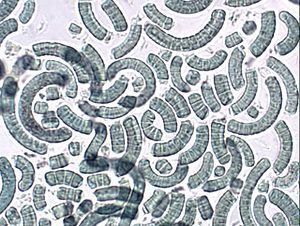
The Arthrospira genus comprises helical trichomes of varying size and with various degrees of coiling, including tightly coiled morphology to even a straight form.
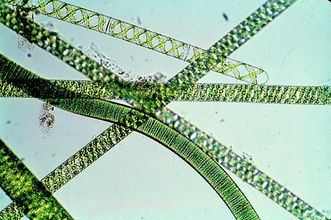
The helical parameters of the shape of Arthrospira is known to differentiate between- and even within the same- species. These differences may be induced by changing environmental conditions, such as the growth temperature. The helical shape of the trichomes is only maintained in a liquid environment. The filaments are solitary and reproduce by binary fission, and the cells of the trichomes vary from 2 to 12 μm and can sometimes reach 16 μm.
Biochemical composition

Arthrospira is very rich in proteins. Contents range from 53 to 68 percent by dry weight. Its protein harbours all essential amino acids. Arthrospira also contain high amounts of polyunsaturated fatty acids (PUFAs), about 1.5-2 percent of the total lipid content of 5-6 percent. These PUFAs contain the γ-Linolenic acid (GLA), an essential Omega-6 Fatty acid. Further ingredients of Arthrospira include Vitamins, Minerals and Photosynthetic pigments. A detailed composition of the proteins and nutrients can be found in the Spirulina (dietary supplement) article.
Occurrence
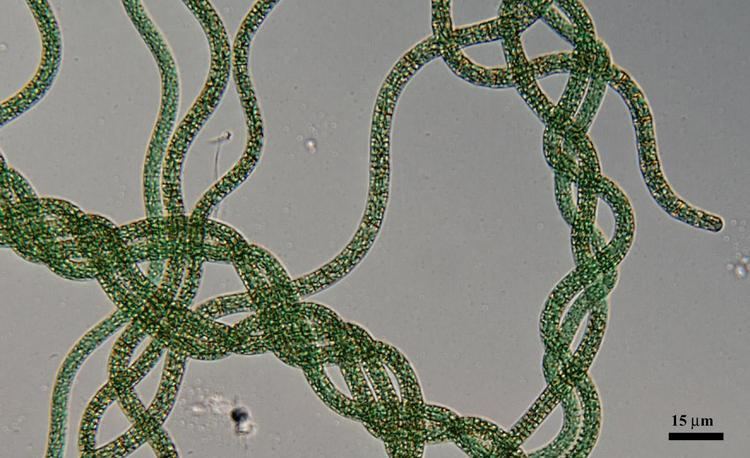
Species of the genus Arthrospira have been isolated from alkaline brackish and saline waters in tropical and subtropical regions. Among the various species included in the genus, A. platensis is the most widely distributed and is mainly found in Africa, but also in Asia. A. maxima is believed to be found in California and Mexico. A. platensis and A. maxima occur naturally in tropical and subtropical lakes with alkaline pH and high concentrations of carbonate and bicarbonate. A. platensis occurs in Africa, Asia, and South America, whereas A. maxima is confined to Central America, and A. pacifica is endemic to the Hawaiian islands. Most cultivated spirulina is produced in open-channel raceway ponds, with paddle-wheels used to agitate the water. The largest commercial producers of spirulina are located in the United States, Thailand, India, Taiwan, China, Pakistan, Burma (a.k.a. Myanmar), Greece and Chile.
Present and future uses
Spirulina is widely known as a food supplement today, but there’s a variety of other possible applications for this cyanobacterium. As an example, it is suggested to be used medically for patients for whom it is difficult to chew or swallow food, or as a natural and cheap drug delivery carrier. Further, promising results in the treatment of certain cancers, allergies and anemia, as well as hepato-toxicity and vascular diseases were found. Next to that, spirulina could also be interesting as a healthy additional animal feed if the price of its production can be further reduced. Spirulina may also be used in technical applications, such as the biosynthesis of silver nanoparticles, which allows the formation of metallic silver in an environmentally friendly way. Also in the creation of textiles it harbors some advantages, since it can be used for the production of antimicrobial textiles. And paper or polymer materials may be produced with this versatile small organism.
Cropping systems
Growth of Arthrospira platensis depends on several factors. To achieve maximum output, factors such as the temperature, light and photoinhibition, nutrients, and CO2 level, need to be adjusted. In summer the main limiting factor of Spirulina growth is light. When growing in water depths of 12–15 cm self-shading governs the growth of the individual cell. However, research has shown, that growth is also photoinhibited, and can be increased trough shading. The level of photoihnhibiton versus the lack of light is always a question of cell concentration in the medium. The optimal growth temperature for A. Platensis is between 35 – 38 °C. This poses a major limiting factor outside the tropics, confining growth to the summer months. A. Platensis has been grown in fresh water, as well as in brackish water and sea water. Apart from mineral fertilizer various sources such as, waste effluents, and effluents from fertilizer, starch and noodle factories have been used as nutrient source. Especially the waste effluents are also available in rural locations, allowing small scale production. One of the major hurdles for larger scale production is the complicated harvesting process that makes up for 20-30% of the total production costs. Due to small size, and diluted cultures (mass concentration less than 1 g/L-1) with densities close to that of water microalgae are difficult to separate from their medium.
Open pond
Open pond systems are the most common way to grow A. Platensis due to their comparatively low cost. Typically, channels are built in form of a raceway from concrete or PVC coated earth walls, and water is moved by paddle wheels. The open design, however allows contamination by foreign algae and/or microorganisms. Decontamination and/or covers increase the price of open pond systems, and thus reduce their main selling point.
Closed system
Closed systems have the advantage of being controllable in terms of physical, chemical and biological environment. This allows for increasing yields, and influencing the nutrient ratio of the organism. Typical forms such as tubes or polyethylene bags, also offer a larger surface to volume ratios than open pond systems, thus increasing the amount of sunlight available for photosynthesis. These closed systems help expanding the growing period into the winter months, but often lead to overheating in summer. Closed systems allow CO2 supplementation to increase growth.
Economy of arthrospira and its market potentials and feasibility
Cultivation of arthrospira has a long tradition, especially in Mexico and around the Lake Chad on the African continent. During the twentieth century however, its beneficial properties were rediscovered and therefore studies about arthrospira and its production increased. In the past decades, large-scale production of the cynobacterium developed. Japan started in 1960, and in the following years Mexico and several other countries over all continents, such as China, India, Thailand, Myanmar and the United States started to produce on large-scale. In little time, China has become the largest producer worldwide. A particular advantage of the production and use of spirulina is that its production can be conducted at a number of different scales, from household culture to intensive commercial production over large areas.
Especially as a small-scale crop, Arthrospira still has considerable potential for development, for example for nutritional improvement. New countries where this could happen, should dispose of alkaline-rich ponds on high altitudes or saline-alkaline-rich groundwater or coastal areas with high temperature. Otherwise, technical inputs needed for new spirulina farms are quite basic.
The international market of spirulina is divided into two target groups: the one includes NGO’s and institutions focusing on malnutrition and the other includes health conscious people. There is still some countries, especially in Africa, that produce at a local level. Those could respond to the international demand by increasing production and economies of scale. Growing the product in Africa could offer an advantage in price, due to low costs of labour. On the other hand, African countries would have to surpass quality standards from importing countries, which could again result in higher costs.
